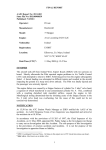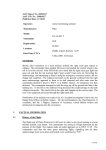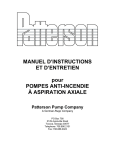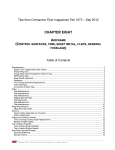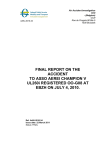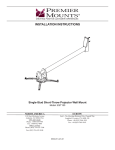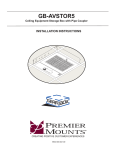Download AAIU Report No
Transcript
AAIU Report No.:2002/011 AAIU File No.: 2002/0015 Published: No.: 30 September 2002 Operator: Manufacturer: Model: Nationality Registration Location Date/Time (UTC) Private Cessna Aircraft Company Cessna 210N Irish EI-CGH Abbeyshrule, Co. Longford. 12 March 2002, 12.50 hours SYNOPSIS. The aircraft took off from Tullamore at 12.35 hours. The pilot noted that the flaps were slow to operate and that the main undercarriage did not appear to retract. At 12.50 he landed at Abbeyshrule Airfield. During the landing roll the aircraft pitched down, the nose undercarriage collapsed and the propeller struck the runway surface. The aircraft came to a halt further down the runway. The pilot exited the aircraft in the normal way and there were no injuries. 1. FACTUAL INFORMATION 1.1 History of the Flight. The aircraft was being flown to a maintenance base at Abbeyshrule for the reinstallation of its VOR/ILS navigation equipment. The pilot found it difficult to start the engine prior to take off from his private airfield at Tullamore. Eventually the engine started and he prepared for take-off with a flap selection of 10º. The pilot noted that the flaps were slow to operate. Following take-off the pilot pulled the undercarriage lever to retract the undercarriage. He then noted that the main undercarriage was still down and returned the lever to the down position. He did not take up the flaps, which were still at 10° and continued the flight. He noted that the low voltage light was on but that there were no other lights showing. The flight lasted 15 minutes. Prior to landing he operated the flap handle in order to increase flap angle but the flaps did not extend beyond 10°, which was already set. He landed the aircraft in this configuration. The aircraft rolled on the main undercarriage for about 40 metres before the nose of the aircraft pitched down and the 3-bladed propeller struck the runway surface. After a further 60 metres the nose undercarriage strut and forward doors contacted the runway for 200 metres and were severely damaged. The aircraft came to a halt on the runway, 300 metres from the touchdown point. The pilot exited the aircraft in the normal way and there were no injuries. There was no fire. 1.1.1 Pilots Report The pilot and owner of the aircraft said that the flight from Tullamore private Airfield to Abbeyshrule took approximately 15 minutes. The aircraft had last flown on 22 January 2002 for a similar short flight to Abbeyshrule where the VOR/ILS Navigation set was removed for repairs. This flight was a return flight in order to have that set refitted. The pilot said that the engine was hard to start at Tullamore. He delayed for about 1 hour and eventually got the engine started. The flaps were set at 10° and the aircraft took off. He pulled on the undercarriage retraction lever to retract the undercarriage. He was not aware of the undercarriage warning lights on take off. He then noticed that the undercarriage remained extended and he put the lever in the down position. The flaps had been slow to operate and he did not take up the flaps after take-off. The low voltage light remained on during the 15 min flight. Before landing at his destination he lowered the flap handle but could not get any increase in flap angle. He said that on landing the front undercarriage wheel did not come down, the aircraft landed on its main wheels and the propeller struck the runway. Subsequently, the pilot stated that on having had difficulty in starting the engine, he used leads to jump-start the engine from a 12-volt car battery. 1.2 Injuries To Persons There were no injuries reported to the investigation. Injuries Fatal Serious Minor None 1.3 Crew 0 0 0 1 Passengers 0 0 0 0 Others 0 0 0 Damage To Aircraft All three blades of the propeller suffered severe tip damage. The front nose strut and front undercarriage doors were damaged as the nose came in contact with the runway surface. 1.4 OTHER DAMAGE There was no other damage apart from scrapes to the runway surface. 2 1.5 Personnel Information: 1.5.1 PF (Commander) Personal Details Licence Male, aged 69 years UK PPL No.PP25655A ( Ref. No. 221630.B) Class Two, 4/3/02 Medical Certificate Flying Experience: Total all types Total on type Total on type PI Last 90 days Last 28 days Last 24 hours 1.6 2200 650 650 8 Nil Nil Aircraft Information 1.6.1 Aircraft type Manufacturer Constructor’s number Year of manufacturer Certificate of registration Certificate of airworthiness Total airframe hours Total cycles Engine Maximum authorised takeoff weight Actual Take off weight Estimated weight at time of incident Centre of Gravity limits (at incident weight) Centre of gravity at time of incident 3 Cessna 210N Cessna Aircraft Company 21063524 1979 16 November 1992 09 July 2001 3687 N/A Continental IO 520 L3B 3800 lbs 2866 lbs 2858 lbs 41.24 ins 41.24 ins hours hours hours hours hours hours 1.6.2 General Information Flights conducted in 2002 prior to the accident were as follows: 2 Jan 4 Jan 1.5 hrs 1.6 hrs To Liverpool Airport From Liverpool Airport. 10 Jan 22 Jan 0.5 hrs 0.4 hrs To Abbeyshrule From Abbeyshrule 12 March Total 0.25 hrs 4.25 hrs To Abbeyshrule The average annual hours flown over the last 3 years was 56 hours. 1.6.3 Aircraft Maintenance The last annual inspection was carried out on 6 July 2001 at 3660 hours flying time. During the following 6 months, up to the time of this accident, only a further 30 hours were flown. The Light Aircraft Maintenance Schedule CAA/LAMS/A/1999 directs that the battery electrolyte level be checked every 50 hours or every 6 months whichever is soonest. The level was due to be checked on 6 Jan 2002. The logbook did not record such check. The maintenance contractor indicated to the investigators that the required capacity check was carried out during the previous annual inspection in July 2001. The electrolyte level would also have been checked and replenished, if necessary, during that inspection. 1.6.4 Aircraft Electrical System Energy for the aircraft is supplied by a 24/28 volt, DC system (24 volt battery and 28 volt alternator). The 24-volt battery supplies power for starting and furnishes a reserve in the event of alternator failure. The alternator is regulated to 27.7 volts, the normal source of power during flight, and maintains a battery charge controlled by the solid-state regulator. The aircraft bus voltage during normal engine operation will be in the region 27.5 + 0.5 volts. An external power receptacle is installed to supplement the battery alternator system for starting and ground operation. If the battery does not supply power in order to crank the engine properly the trouble-shooting recommended by the manufacturers in their Service Manual is as follows: 1. Measure voltage at “BAT” terminal of battery contactor with master switch on and a suitable load such as a taxi light switched on. 4 2. If the voltage is low check the fluid in the cells and charge at 28 volts for approximately 30 minutes until the battery voltage rises to 28 volts. If not, replace the battery. 1. 6. 5 Before Take-Off Checks Prior to flight, verification of proper alternator regulator operation should be made by loading the electrical system momentarily with the landing light switched on, or operating the wing flaps, and observing the ammeter reading at the same time. The ammeter indicates the flow of current, in amperes, from the alternator to the battery or from the battery to the aircraft electrical system. When the engine is operating and the master switch is “ON”, the ammeter indicates the charging rate applied to the battery. In the event that the alternator is not functioning or the electrical load exceeds the output of the alternator, the ammeter indicates the discharge rate of the battery. 1. 6. 6 Landing Gear System A hydraulically-operated, retractable landing gear is employed on this aircraft. The nose unit retracts forward with the main units retracting aft and inward. The hydraulic power system includes equipment required to provide a flow of pressurized hydraulic fluid to the landing gear system. The self-contained, hydro-electric pack is located in the pedestal with the hand pump remotely located between the two front seats on the floorboard. The gear select lever is located on the lower left instrument panel. When the aircraft master switch is closed, the hydraulic power pack is ready to operate. When the gear-up position is selected with the selector lever, the gear valve solenoid connects the gear-up line to the system pressure, and the gear-down line to return. At the same time, the electric motor that powers the hydraulic pump is turned on. The hydraulic pressure is passed through a filter, and is then divided between the gear valve and door valve. Before hydraulic pressure can reach the gear valve, a priority valve must open. The priority valve can open only under two conditions: · There can be no pressure in the door close line( because door close pressure is applied to a piston to hold the priority valve closed) · System pressure must build up to 750 psig before the priority valve can open. 5 The system is designed so that whenever the undercarriage lever is moved to the up or down position, the undercarriage doors must move to the open position before the gear starts to move. The Cessna 210 Service Manual has a note as follows: Ø The electro-hydraulic power pack motor requires a nominal 20 amps at 27.5 volts during gear operation with starting current peaking out at 30 amps. If the motor is operated in the shop on the ship’s battery (engine not running), then system voltage is only 22 to 24 volts during first and second gear cycles. It may be even less if the ship’s battery is old or partially discharged. During landing gear system servicing, a power supply capable of maintaining 27.5 volts throughout the gear cycle must be used to augment the ship’s battery. Ø The power pack includes an electrically-driven pump and two electric solenoid shuttle valves. These valves are normally energized during flight (gear retracted, doors closed). The door valve is de-energized during the doors open and gear cycling action. The door valve is re-energized at the end of the gear extension or retraction cycle, causing the doors to close. The pump motor is putting forth its maximum effort at about the same time the door valve is energized. If the battery-alternator combination is not maintaining 27.5 volts, the gear valve may not shuttle.* The doors remain open and the pump continues to run. The typical door solenoid will operate at 21.0 to 21.5 volts when hot. In a service shop, when cycling the gear using a limited capacity power source, the voltage required to energize the door solenoid may not be developed. * i.e. operate properly 1.7 Meteorological Information 1.7.1 Forecast Conditions: Wind Direction and Speed: Visibility: Actual Conditions 1.8 North East / 15 kt Good (as reported by the pilot): Aids to Navigation Not a factor. 6 Good VFR 1.9 Communications Not a factor 1.10 Aerodrome Information Abbeyshrule Aerodrome is 12 NM WNW of Mullingar. Runway 10/28 has a tarmac surface of length 575 metres and width 118 metres. 1.11 Flight Recorders There were no flight recorders on board nor were they required. 1.12 Wreckage and Impact Information Slight superficial impact damage was caused to the runway surface for about 60 metres due to the three bladed propeller striking the surface followed by marks caused by the forward doors for another 200 metres. 1.13 Medical Information Not applicable 1.14 Fire There was no fire 1.15 Survival Aspects The pilot used the lap and diagonal harness installed. He used the normal crew door to exit the aircraft. 1.16 Battery Removal and Test The battery was removed for bench testing by the Investigation. The result of this test indicated that on receipt the capacity was only 3.8% of nominal capacity and the specific gravity (SG) was 1.175 (should be between 1280 and 1300). Only one of the 12 cells had sufficient electrolyte to take a sample of fluid. The battery was deemed unserviceable on receipt. Following appropriate servicing the battery recovered and was eventually passed as serviceable. The full test is recorded at Appendix A. 7 1.17 Organizational and Management Information The aircraft was privately owned and operated from a remote private airfield where aviation ground equipment, such as an external power source, was not available. 1.18 Additional Information After repair and rectification of the aircraft had been completed and with the original alternator and regulator installed, the following checks of the electrical charging system were carried out: Voltage at battery All switches off 24.19 Engine at idle speed with pitot heat and exterior lights on 24.42 as above at 1500 RPM as above at 2000 RPM 27.75 27.80 These tests confirm that the charging system was capable of producing the correct voltage prior to the incident had the battery been serviceable. 2. ANALYSIS The results of the battery test indicate that such a low level of electrolyte would not provide the energy required by the engine manufacturers to start the engine. When the engine did start, there was insufficient battery voltage to the alternator field circuit in order to produce a charging voltage. A fully charged 12 volt battery would have enough energy to crank and start the engine. However, as the voltage regulator is designed for a 24-volt system it would have been unable to sustain the appropriate alternator field voltage. The alternator would therefore be unable to produce the 24 volts necessary to charge the battery and operate the systems. To connect a 12-volt car battery to a 24-volt aircraft system is both dangerous and contrary to safe aircraft practice. There is a 24-volt ground service receptacle, which is suitably protected, provided on the aircraft. This is the only way by which the aircraft may be serviced with external power. The only light observed by the pilot was the “low voltage” warning light. Before take-off, there was insufficient battery power to move the flap system. The aircraft therefore failed the “before take-off checks”. After take-off, there was sufficient power remaining to unlock and start to move the nose undercarriage. However it remained half retracted during the subsequent flight. The voltage available was insufficient to unlock and raise the main undercarriage. When the pilot put the undercarriage 8 lever in the down position there was now insufficient remaining battery power to lower and lock the nose undercarriage. When the aircraft landed on its main wheels the nose pitched forward. The propeller struck the ground followed by the nose undercarriage and it’s forward doors. The starting of the engine did not involve an approved procedure for the aircraft concerned. Correct procedures are contained in the Aeroplane Flight Manual. With reference to incorrect procedures involving light aircraft the IAA issued an Aeronautical Information Circular, NR 5/87, following an accident involving incorrect take-off procedures. It concluded: “Pilots should adhere to the procedures laid down in the Flight Manual for the aircraft concerned and are reminded of the inherent risks associated with the use of non- approved techniques and procedures.” 3. CONCLUSIONS 3.1 Findings 3.1.1 The aircraft had not been maintained in accordance with the appropriate maintenance schedule (CAA/LAMS/A/1999 Issue 1). 3.1.2 The aircraft was not serviced in accordance with the manufacturers service manual prior to take off. 3.1.3 Having failed to initially start the engine on the aircraft battery, the pilot jump-started the engine with his 12-volt car battery. 3.1.4 The aircraft battery power after engine start and prior to take–off was insufficient to operate both the flap and undercarriage systems. 3.1.5 The aircraft was known to be in an unserviceable condition prior to takeoff. However, the pilot chose to continue with the flight. 3.2 Causes 3.2.1 The nose wheel half retracted after take –off and failed to fully lock down for landing. On landing, the unlocked nose wheel collapsed, causing extensive damage to the propeller, nose wheel and nose wheel doors. 3.2.2 A contributory factor was that the pilot elected to commence flight in the knowledge that the aircraft was unserviceable. 9 4. SAFETY RECOMMENDATIONS 4.1 The IAA should consider the re-issue of AIC NR5/87 in order to include a reference to “before take-off”, in addition to “take-off” procedures. (SR 26 of 2002) 10 Appendix A Ref. Aviall Battery A-242 Ser. No. A0058222 The following tests were carried out in accordance with manufacturers instructions: 1. Visual inspection: no obvious defects detected 2. Sg measurement: Sg=1.175 (note the measurement could not be taken from 11 cells as the liquid level was too low). 3. Residual capacity test: Battery capacity = 3.8% 4. Full recharge and liquid top up: Sg = 1.285 Water added 30cc average per cell. 5. 2nd capacity test: Battery capacity = 72.8% (pass = 80%) 6. Full charge as per no. 4 above: Sg = 1.285 No water added 7. Final capacity test: Capacity = 86.6% (pass = 80%) 8. Full recharge as 5 above Interpretation of test results: The battery was unserviceable on receipt by the AAIU. Following the above servicing, the battery recovered and is now deemed to be serviceable 11











